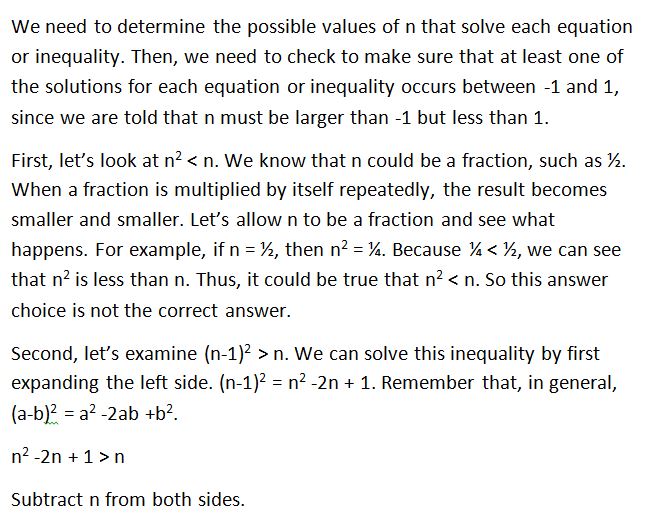How to find the solution to an inequality with multiplication
Help Questions
SAT Math › How to find the solution to an inequality with multiplication
We have 
Explanation
If –1 < n < 1, all of the following could be true EXCEPT:
n2 < n
|n2 - 1| > 1
(n-1)2 > n
16n2 - 1 = 0
n2 < 2n
Explanation
Fill in the circle with either 




None of the other answers are correct.
The rational expression is undefined.
Explanation
Let us simplify the second expression. We know that:
So we can cancel out as follows:
Give the solution set of this inequality:
The set of all real numbers
Explanation
The absolute value inequality
can be rewritten as the compound inequality

Solve each inequality separately, using the properties of inequality to isolate the variable on the left side:
Subtract 17 from both sides:
Divide both sides by 

which in interval notation is
The same steps are performed with the other inequality:
which in interval notation is ![(-\infty, -12.5 ]](https://vt-vtwa-assets.varsitytutors.com/vt-vtwa/uploads/formula_image/image/787071/gif.latex)
The correct response is the union of these two sets, which is
![(-\infty, -12.5 ] \cup [21, \infty )](https://vt-vtwa-assets.varsitytutors.com/vt-vtwa/uploads/formula_image/image/787072/gif.latex)
Find the maximum value of 
Explanation
First step is to rewrite
Next step is to find the vertices of the bounded region. We do this by plugging in the x bounds into the 
The vertices are
Now we plug each coordinate into 
So the maximum value is
What value must 
Explanation

Add 
Multiply each side of the inequality by 
Multiply each side of the inequality by 
Divide each side of the inequality by 
You can now change the fraction on the right side of the inequality to decimal form.
The correct answer is 

(√(8) / -x ) < 2. Which of the following values could be x?
All of the answers choices are valid.
-4
-3
-2
-1
Explanation
The equation simplifies to x > -1.41. -1 is the answer.
Solve for x



















![(-\infty, -12.5 ] \cup [21, \infty )](https://vt-vtwa-assets.varsitytutors.com/vt-vtwa/uploads/formula_image/image/786962/gif.latex)
![[-12.5, 21]](https://vt-vtwa-assets.varsitytutors.com/vt-vtwa/uploads/formula_image/image/786963/gif.latex)
![[-21, 12.5]](https://vt-vtwa-assets.varsitytutors.com/vt-vtwa/uploads/formula_image/image/786964/gif.latex)
![(-\infty, -21 ] \cup [12.5, \infty )](https://vt-vtwa-assets.varsitytutors.com/vt-vtwa/uploads/formula_image/image/786965/gif.latex)





















































